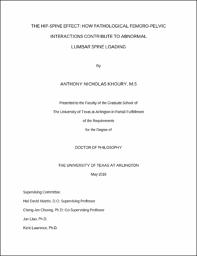
ATTENTION: The works hosted here are being migrated to a new repository that will consolidate resources, improve discoverability, and better show UTA's research impact on the global community. We will update authors as the migration progresses. Please see MavMatrix for more information.
Show simple item record
| dc.contributor.advisor | Martin, Hal D | |
| dc.contributor.advisor | Chuong, Cheng-Jen | |
| dc.creator | Khoury, Anthony Nicholas | |
| dc.date.accessioned | 2020-06-23T22:11:27Z | |
| dc.date.available | 2020-06-23T22:11:27Z | |
| dc.date.created | 2019-05 | |
| dc.date.issued | 2019-05-06 | |
| dc.date.submitted | May 2019 | |
| dc.identifier.uri | http://hdl.handle.net/10106/29173 | |
| dc.description.abstract | ABSTRACT
THE HIP-SPINE EFFECT: HOW PATHOLOGICAL FEMORO-PELVIC
INTERACTIONS CONTRIBUTE TO ABNORMAL LUMBAR SPINE LOADING
Anthony Nicholas Khoury, Ph.D.
The University of Texas at Arlington, 2019
Supervising Professor: Hal David Martin
Cheng-Jen Chuong
Lumbar pathology has been shown to explain hip pain, as hip pathology is involved in the development of lumbar pain by the disruption of normal lumbopelvic kinematics. Hip pathologies that contribute to lumbar pain include flexion deformities, osteoarthritis, congenital hip dislocation, and limited hip range of motion. To date there is a paucity of research that actively looks to investigate the symbiotic relationship between the hip and the spine. Specific pathologies and treatment methods have largely focused on the individual components without considering the global effects of the structures involved. The biomechanics of hip pathology must be studied in depth in order to provide a discreet knowledge of diseases.
Ischiofemoral impingement, femoroacetabular impingement, and femoral version are commonly diagnosed and treated hip pathologies, however altered biomechanics are poorly understood. The hypothesis states lumbar pain can be generated by increased force transmission through the spine as a result of abnormal hip anatomy during normal gait movement of hip flexion and extension. Ischiofemoral impingement, femoroacetabular impingement, and femoral version will have a positive impact on force generation to the lumbar spine region, ultimately resulting in primary pain complaints. The biomechanical effects of these specified abnormal hip pathologies on the lumbar spine will be investigated with the development of novel cadaveric pathology simulations. The lumbar spine loading will be further studied using a developed Finite Element Analysis model to further quantify the underlying biomechanics.
Three analytical techniques were utilized to quantify the relationship between the hip pathologies and lumbar pain. 1) The hip pathologies investigated were reproduced in a cadaveric model and tested in various phases of hip extension and flexion and compared to native hip anatomy. The cadaveric model provides a reasonable medium for testing due to real-life conditions and variability within samples that reflect a more normal population. 2) Gait analysis techniques were utilized to study specific lumbopelvic motion in decreased femoral version cases. 3) Finite Element Analysis models were then created to simulate normal and pathological hip conditions and tested in the corresponding hip flexion and extension movements. Regional deformation and load change in the lumbar region as a consequence of abnormal hip anatomy will provide valuable information on how the hip affects the spine.
Cadaveric experiments to simulate the related hip pathologies proved successful in establishing a direct kinematic chain link between abnormal hip pathology and the lumbar spine. Simulated ischiofemoral impingement increased L3-4, L4-5, and L5-S1 facet joint loading during 10° and 20° hip extension, when compared to native hip specimens. Simulated cam-type femoroacetabular impingement displayed similar results. An increase in L3, L4, and L5 intervertebral disk loading was observed in the presence of anterior hip impingement, when compared to normal hips. Abnormal femoral version experiments produced interesting data during which decreased femoral version (-10°) reduced lumbar facet joint loading when compared to native hip specimens. Conversely, increased femoral version (+30°) elevated lumbar facet joint loading when compared to native hips. A gait study investigating patients with imaging-based confirmed decreased femoral version resulted in significant differences in lumbopelvic movement and ground reaction force when compared to healthy individuals. The finite element analysis models developed accurately reflected similar trends in lumbar loading increase or decrease during hip flexion and extension.
The resultant data obtained from cadaveric benchtop experiments, gait/motion analysis, retrospective clinical studies, and finite element analysis confirms the deleterious impact abnormal hip pathology has on the lumbar spine. The excessive loading experienced within the lumbar spine, due to abnormal hip pathology, generates primary low back pain complaints. Examination of the hip joint anatomy is imperative during low back physical examination to investigate any deviations within the kinematic chain. The advanced understanding of these hip pathologies allows for more comprehensive surgical and conservative treatment planning. | |
| dc.format.mimetype | application/pdf | |
| dc.language.iso | en_US | |
| dc.subject | Ischiofemoral impingement | |
| dc.subject | femoroacetabular impingement | |
| dc.subject | femoral version | |
| dc.subject | hip pathology | |
| dc.subject | low back pain | |
| dc.subject | lumbar spine | |
| dc.title | The Hip-Spine Effect: How Pathological Femoro-Pelvic Interactions Contribute to Abnormal Lumbar Spine Loading | |
| dc.type | Thesis | |
| dc.degree.department | Bioengineering | |
| dc.degree.name | Doctor of Philosophy in Biomedical Engineering | |
| dc.date.updated | 2020-06-23T22:11:27Z | |
| thesis.degree.department | Bioengineering | |
| thesis.degree.grantor | The University of Texas at Arlington | |
| thesis.degree.level | Doctoral | |
| thesis.degree.name | Doctor of Philosophy in Biomedical Engineering | |
| dc.type.material | text | |
| dc.creator.orcid | 0000-0002-7418-5605 | |
Files in this item
- Name:
- KHOURY-DISSERTATION-2019.pdf
- Size:
- 1.738Mb
- Format:
- PDF
This item appears in the following Collection(s)
Show simple item record


